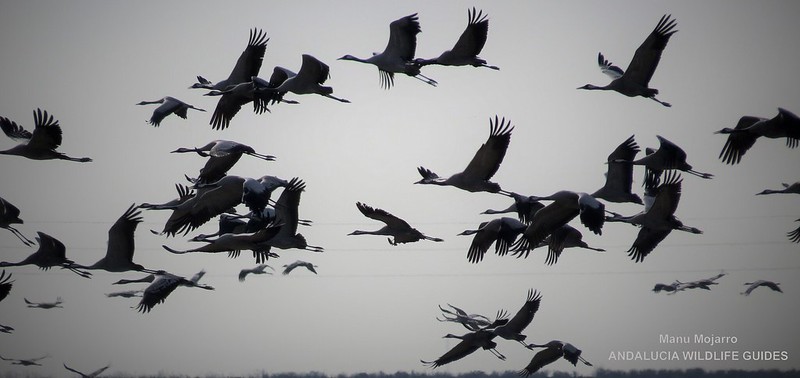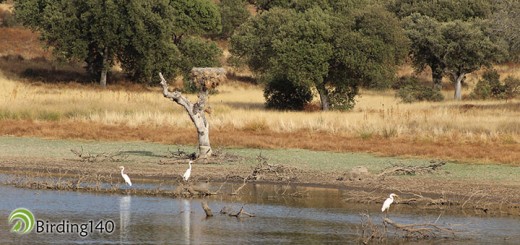Eight o´clock in the morning in the marshes of the River Tinto. The first sunbeams shine behind Moguer “the light with the time inside” as defined by the local Nobel Award, Juan Ramón Jiménez. Until then, the marsh looks deserted but at dawn, tranquillity and silence give way to the bustle of the awakening of thousands of birds that roost in the channels of the estuary. Over 50,000 gulls, the most Black-headed and Lesser Black-backed Gulls, dozens of Greylag Geese and about 300 Common Cranes which come from different parts of north-eastern Europe, including Estonia and Finland, to spend the winter in Huelva.
The seagulls are always the earliest birds but not to go to sea, but the nearest rubbish tip inland. By contrast, our friends the cranes are lazy and wait until the sun is fully visible to sound the first trumpet of the day indicating it is time to take a flight and go find a good breakfast, which is definitely the most exciting time of the morning. That first meal of the day is found only a few kilometres away, in the countryside of Huelva, where the Cranes beat the wheat and sunflower fields with his impassive walk searching for the grain and pipes that the machines left behind in the previous harvest. Still, the most anticipated moment for those big birds is the planting of wheat, in which the Cranes behave as they were Cattle Egrets, chasing the tractors to eat the freshly seeds deposited on the ground. It is a curious fact to note, although not all equally enjoy, as farmers make sound their horns to scare the birds! But without much success, indeed.
The abundance of food in the Autumn-Winter attracts many other birds to the farmland in huge flocks: Calandra and Crested Larks, Skylarks, Goldfinches, Linnets, Chaffinches, House and Spanish Sparrows, migratory Northern Wheatears, Meadow Pipits, White Wagtails, Spotless Starlings and doves and pigeons which in turn attract predators such as Marsh and Hen Harriers, Kestrel, Peregrine, Merlin, Sparrowhawk, Black-winged Kite and Buzzard. Moreover, although the picture of the Cranes wandering the wheat fields is beautiful, they will give us a better one in their next daily stop. Once they have accumulated some energy, it is time to travel a few miles inland in search of their favourite lunch… acorns in the fighting bull farms.
The major representative Iberian wild landscape is the traditional wood-pasture known as dehesa, the preferred habitat by the most of the 150,000 plus cranes that each year travel into Spain to overwinter. The brave bull farms located north of the countryside of Huelva are equidistant to the two roosting sites that cranes use in this province, said River Tinto´s estuary and the River Odiel, the quintessential rivers of Huelva that Cranes use randomly according to their convenience. The vision in the same frame of an imposing bull and a graceful and pompous Crane is one of the images that any nature lover will never forget.
At dusk, it is time to return to roost. The Eucalyptus trees on the edge of the marsh provide the perfect hide to get such a close view of the Cranes in flight that we better forget about binoculars to enjoy the moment. At sunset, trumpeting ceases and silence again becomes master of the marsh.
Manu Mojarro
Wildlife guide
info@spoontrips.com
www.spoontrips.com
Manu is a wildlife enthusiast almost since birth. Has 10 years experience as group leader and heritage expert, and has been organising professional birding and walking tours since 2004. Due to his love for Nature, he founded with Diego Vázquez the company Platalea and the non-profit organization Brizna to preserve local natural and historical-cultural heritage. However, his latest project is Doñana Spoonbill Trips for a full-time dedication to lead birdwatchers and walkers from all over the world.
Through these years, Manu has been taking to the field thousands of people from Spain, Great Britain, USA, Germany, Holland, Poland, Sweden, Norway, Switzerland, France, Ireland? Besides, he usually participates in local bird ringing and tracking as a volunteer.













